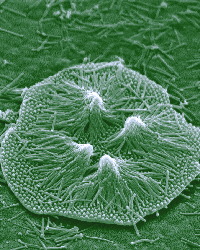Smart Nanotubules For Bioseparations and Biocatalysis
Department of Chemistry, University of Florida,
Gainesville, FL 32611-7200 USA
This is an abstract
for a presentation given at the
Ninth
Foresight Conference on Molecular Nanotechnology.
There will be a link from here to the full article when it is
available on the web.
We have been exploring a “template synthesis” method of producing nanomaterials(1-2). This process involves synthesizing the desired material in the pores of a microporous membrane or other solid. The pores in these materials are cylindrical and highly monodisperse. The resulting nanomaterial is correspondingly cylindrical and monodisperse, and can be either hollow (nanotubules) or solid (nanowires). We have used this method to prepare nanostructures composed of metals(3), semiconductors(4), and conductive polymers(5).
This talk will describe the preparation of SiO2 nanotubules from porous aluminum oxide templates. The nanotubules can be modified with a variety of chemistries, typically via a silanization process. Enzymes and other proteins can also be covalently attached to the nanotubules. The modified nanotubules can be used as selective extractants or, when modified with enzymes, as removable catalytic bioreactors.
For example, modifying the interior of the nanotubules with a C-18 silane makes them hydrophobic. We then use the C-18 modified nanotubules to extract hydrophobic drugs from aqueous solution. These tubules may prove useful in decreasing the toxicity of overdosed drugs by adsorbing the drug from the bloodstream. Extraction efficiencies range from 45% to 85%, with higher efficiencies for lower initial drug concentrations.
Protein modified nanotubules can also be used for extractions and bioseparations. Proteins are attached through an aldehyde silane bridge that binds to their pendant primary amino groups. High extraction efficiency is seen for an avidinated nanotubule/biotinylated Au nanoparticle system in which, within our ability to measure, all the Au nanoparticles were removed. High specificity is shown by an IgG modified nanotubule/anti-IgG immunoprotein system. For this system, no removal of non-specific antibody was seen, while most of the specific antibody was extracted. We can also use enantioselective proteins to separate one enantiomer from a racemic mixture.
Glucose oxidase has been shown to retain its catalytic activity after attachment to the nanotubules. P450 liver enzymes have also been attached and shown to be functional. P450 enzymes have the ability to degrade a variety of drug compounds, and thus may be another route toward diminishing the toxicity of overdosed drugs.
Additionally, the interior and exterior surface of the nanotubules can be modified independently. For example, because the C-18 silanization is done while the tubules are still in the template, only the interior is modified. Thus the C-18 modified nanotubules have a hydrophobic interior while the exterior is hydrophilic SiO2. This aids in the dispersion of the nanotubules in aqueous solution. Other dual chemistry nanotubules can be prepared in which the inside is filled with a dye-containing polymer and the outside modified with protein.

References
- Martin, C. R.; Mitchell, D. T. Anal. Chem., 1998, 70, 322A-327A.
- Martin, C. R.; Mitchell, D. T. In Electroanalytical Chemistry; Bard, A. J., Rubenstein, I., Eds.; Marcel Dekker: New York, 1999; Vol. 21, pp 1-74.
- Cepak, V.M.; Martin, C.R. Chem. Mater., 1999, 11, 1363-1367.
- Lakshmi, B.B.; Patrissi, C.J.; Martin, C.R., Chem. Mater., 1997, 9, 2544-2550.
- Sapp, S.A.; Mitchell, D.T.; Martin, C.R. Chem. Mater., 1999, 11, 1183-1185.
*Corresponding Address:
Charles Martin
Department of Chemistry, University of Florida
Box 117200, Gainesville, FL 32611-7200 USA
Phone: 352 392 7522
Fax: 352 392 4651
Email: [email protected]
http://www.chem.ufl.edu/~crmartin/
|